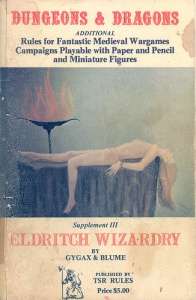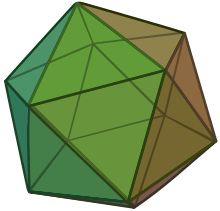Eldritch Wizardry
 | |
| Author | Gary Gygax and Brian Blume |
|---|---|
| Genre | Role-playing game |
| Publisher | TSR, Inc. |
Publication date | 1976 |
| Pages | 60 |
Eldritch Wizardry is a supplementary rulebook by Gary Gygax and Brian Blume, written for the original edition of the Dungeons & Dragons (D&D) fantasy role-playing game, which included a number of significant additions to the core game. Its product designation is TSR 2005.
Contents
Eldritch Wizardry introduced psionics and the druid character class.[1] The sixty page supplement added several other new concepts to the D&D game, including demons (and their lords Orcus and Demogorgon), psionics-using monsters (such as mind flayers), and artifacts (including the Rod of Seven Parts and the Axe of the Dwarvish Lords).[2]
Publication history
Eldritch Wizardry was written by Gary Gygax and Brian Blume and published by TSR in 1976 as a sixty-page digest-sized book, and was the third supplement to the original D&D rules.[3] The supplement was part of the continued expansion of D&D in 1976, which also included Gods, Demi-Gods & Heroes and Swords & Spells.[4]:8
It bears the designation Supplement III, following the Greyhawk and Blackmoor supplements, which were released the previous year,[5] and its product number was TSR 2005. Illustrations were provided by David C. Sutherland III, Tracy Lesch, and Gary Kwapisz, with a cover by Deborah Larson. The booklet was edited by Tim Kask.[6]
John Eric Holmes' 1977 Dungeons & Dragons Basic Set was a revision of the original Dungeons & Dragons plus the Greyhawk, Blackmoor, and Eldritch Wizardry supplements.[4]:10 Some of the anti-D&D moral panic had started with the 1976 publication of Eldritch Wizardry.[4]:13
The Eldritch Wizardry supplement will be reproduced as a premium reprint on November 19, 2013, as part of a deluxe, premium reprint of the original "White Box" which features new packaging in an oaken box. Each booklet will feature new cover art but will otherwise be a faithful reproduction of the original, including original interior art.[7]
Reception
Space Gamer Magazine gave a positive review, saying "It's as good as Greyhawk, and that's saying a lot. It should put the spice of danger and unpredictability back into D&D, and partially satiate that hunger for new material that typifies D&D enthusiasts everywhere."[8]
RPGNet reviewed the book in 2001 as vintage nostalgia saying "Style: 4 (Classy and well done) Substance: 4 (Meaty) From the depths of RPG history, it's one of the books that started it all."[9]
References
- ↑ Tresca, Michael J. (2010), The Evolution of Fantasy Role-Playing Games, McFarland, p. 62, ISBN 078645895X
- ↑ "Original D&D Supplements". The Acaeum. Retrieved 2009-01-17.
- ↑ Schick, Lawrence (1991). Heroic Worlds: A History and Guide to Role-Playing Games. Prometheus Books. p. 140. ISBN 0-87975-653-5.
- 1 2 3 Shannon Appelcline (2011). Designers & Dragons. Mongoose Publishing. ISBN 978-1-907702-58-7.
- ↑ "The History of TSR". Wizards of the Coast. Archived from the original on 2008-10-04. Retrieved 2005-08-20.
- ↑ "Eldritch Wizardry (1976)". Pen & Paper RPG Database. Retrieved 2009-01-17.
- ↑ "Original Dungeons & Dragons RPG". Wizards of the Coast. Retrieved June 24, 2013.
- ↑ The Space Gamer #7. Metagaming. 1976. p. 11.
- ↑ "Eldritch Wizardry". RPGNet. Retrieved 2001-02-05.
